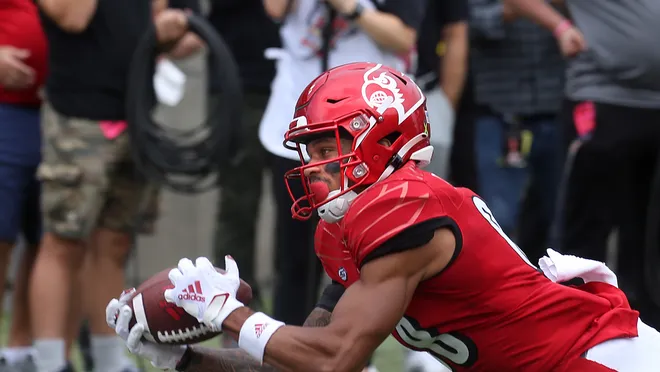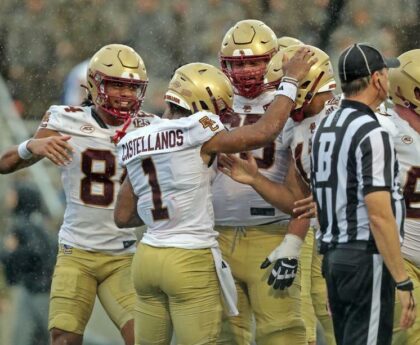Well, the circus that is the NCAA continues to find new ways to amaze me.
If you’re a fan of college athletics or even participated in them, surely you know the epidemic that is sweeping the college landscape.
It’s not drugs.
It’s not protesting.
It’s YouTube.
Believe it or not, it’s not a typo. That really does say YouTube.
Over the last few months, we have seen an interesting display of what could be easily described as an improper use of power and a neglect to common sense by the NCAA.
First, let’s start with Donald De La Haye’s situation.
For those of you who are unaware, De La Haye was a one-year starter as a kicker for the UCF Golden Knights football program and was slated to be the team’s starter this season. Aside from his following as the special teams specialist for UCF, he had his largest following in a different aspect.
He was a world-renowned YouTuber.
For a student who is a marketing major, what an interesting platform to apply what he has learned in his classes than YouTube.
Remember, despite what L.A. Chargers and former Ohio State Buckeye quarterback Cardale Jones tweeted earlier in his scholastic career, these athletes, in fact, come to school to “play school.”

Football is just another perk to the gig.
However, the money-hungry NCAA didn’t take to kindly to his videos and was ultimately suspended by UCF to what I would guess to be a course to “save face” from an NCAA investigation.
De La Haye announced the suspension through his YouTube page:
De La Haye was invited on the Dan Patrick Show days later to discuss the situation:
Now, be sure to keep everything the UCF kicker says to the crew of the show stored in the back of your mind.
Just a few months after De La Haye’s situation, the NCAA is now putting the kibosh on Ryan Trahan’s channel, a freshman long-distance runner for the Texas A&M track and cross country teams. He announced his situation on his YouTube page Wednesday.
Now, before we go on a journey that should show just how hypocritical the NCAA actually is, let’s take a look at the NCAA mission statement.
According to the “Core Values” of the NCAA Mission Statement, it states:
The Association – through its member institutions, conferences and national office staff – shares a belief in and commitment to:
- The collegiate model of athletics in which students participate as an avocation, balancing their academic, social and athletics experiences.
- The highest levels of integrity and sportsmanship.
- The pursuit of excellence in both academics and athletics.
- The supporting role that intercollegiate athletics plays in the higher education mission and in enhancing the sense of community and strengthening the identity of member institutions.
- An inclusive culture that fosters equitable participation for student-athletes and career opportunities for coaches and administrators from diverse backgrounds.
- Respect for institutional autonomy and philosophical differences.
- Presidential leadership of intercollegiate athletics at the campus, conference and national levels.
NCAA.org
Interesting.
The third bullet point really highlights the hypocrisy of the NCAA.
“The pursuit of excellence in both academics and athletics.”
Now, that statement is sort of blah. As they have proven, the NCAA is only behind the student-athletes if it doesn’t hinder the possibility of the NCAA continuing to exploit college athletes.
Yes, you read that right. As long as it doesn’t hinder the possibility of the NCAA to exploit college athletes.
It’s no secret. The NCAA has made a killing, a $995.9 million killing to be exact. And this isn’t a situation where there is an exchange of hands of these so-called “improper benefits.” It wasn’t an Ohio State situation where players gave away bowl game memorabilia in exchange for tattoos. It wasn’t a University of Miami situation where a “booster” – later known as an imposter from the start – was clinging to the Hurricanes football program and throwing parties for its athletes.
This is a situation where students, who are also an outstanding athlete, found a way to support himself the right way. Now, it wasn’t a traditional 40-hour a week job, but it was a job that not only he had to put in a tremendous amount of work, but was also implying the knowledge from their academics to help further the – as the NCAA noted in its mission statement – the pursuit of excellence in both academics and athletics AND in the collegiate model of athletics.
What makes this topic so pivotal in the cases of whether or not each player should be allowed to keep their pages is the fact that normal, every day students are still able to have the opportunity to somehow, someway profit from their likeliness, which could include the school in which they attend. “An inclusive culture that fosters equitable participation for student-athletes and career opportunities for coaches and administrators from diverse backgrounds.”
Equitable’s definition is fair and impartial. So, if regular, every day students are able to generate money while attending an NCAA institution, shouldn’t that mean that the student-athletes could as well?
They, being the NCAA, certainly can’t be talking about “fair and impartial” participation in an athletic setting. Here’s a spoiler, college sports are not fair. Plain and simple. The best compete. So if they refer to that statements in an athletic setting, every John Doe that’s upset that Player A is seeing more snaps than him or that Player B dressing for games and he doesn’t is breaking the balance of equitable participation.
And this is only scratching the surface of the NCAA. There are enough words on the conduct of their transfer policy alone that would make for a meaty column.
This is simply about the exploitation of college athletes.
Remember the NCAA video game franchises?
You know the one football game everyone looks at getting year after year?
What if I told you that top-tier programs or Power 5 schools, made an average of $78,000 off of NCAA 14?
None of that money, not a single penny went to the athletes that were exploited for the profit of that game.
The movement is continuing to roll forward and it’s starting to gain much-needed steam.
And for those who state there simply isn’t enough money for college sports for players to receive some sort of stipend, take a look at the prices of some of the locker room upgrades that took place at some Power 5 schools. $55 million, $65 million, $108 million and etc.
There is money and with all the hassle about players branching out and creating their own companies, it will only be a matter of time until these college athletes are treated appropriately. Until then, we’ll all just have to sit back and continue to shake our heads on the well-documented mistakes the NCAA is making.
Author Profile
- Josh Zimmer is the Lead NFL Draft analyst for NGSC Sports as well as serving as a contributor for NHL coverage.
Latest entries
 Featured ProspectsFebruary 20, 2018Minot State QB Zac Cunha aims to fulfill childhood dream
Featured ProspectsFebruary 20, 2018Minot State QB Zac Cunha aims to fulfill childhood dream Featured ProspectsFebruary 10, 2018The traits that make Nathan Shepherd an effective pass rusher
Featured ProspectsFebruary 10, 2018The traits that make Nathan Shepherd an effective pass rusher Featured ProspectsFebruary 3, 2018Taven Bryan: A ‘flashy’ prospect in need of refinement
Featured ProspectsFebruary 3, 2018Taven Bryan: A ‘flashy’ prospect in need of refinement Mock DraftsJanuary 29, 2018Zimmer’s 2018 NFL Mock Draft 1.0
Mock DraftsJanuary 29, 2018Zimmer’s 2018 NFL Mock Draft 1.0





